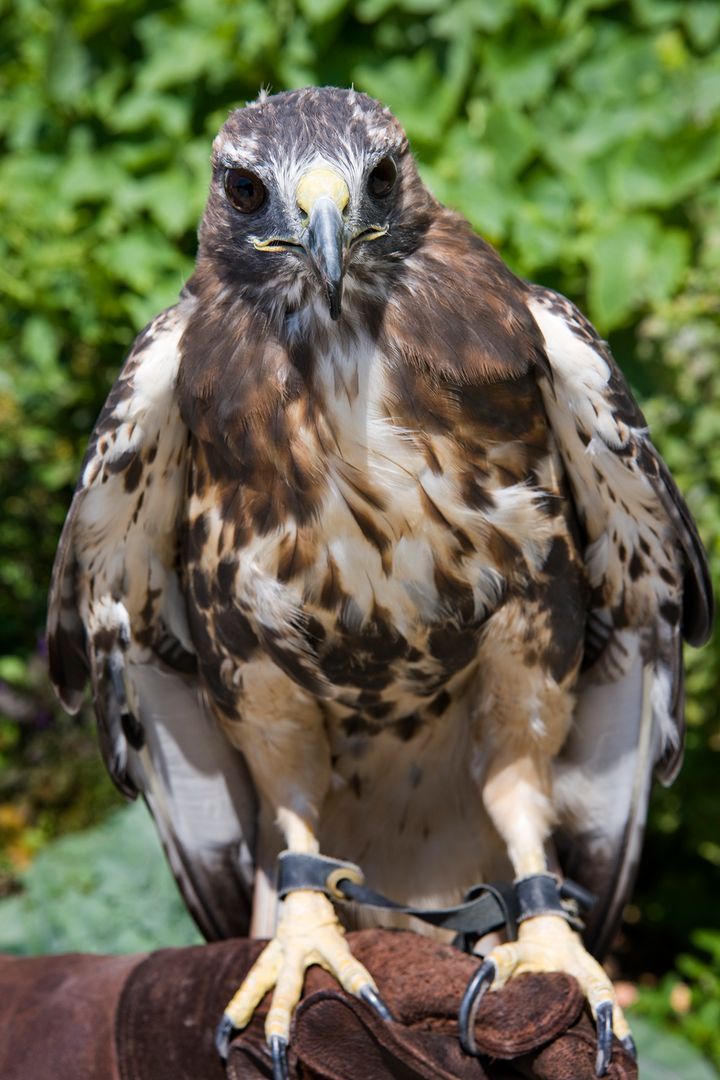When you think of an aquarium, hawks and owls are probably not the first animals you think of. But yes, Shedd Aquarium is home to several of these birds and has been caring for them for more than a decade. In addition to the 42 other birds, including nine ducks, 31 penguins, one jacana and one aracari, we have four hawks and two owls. These are collectively referred to as birds-of-prey or raptors. All our raptors are unique in many ways and require a specialized health plan.

Prescribing the Best Possible Care for Raptors
Raptors regularly require and spend time outside, flying in a specially designed area. For this reason, we have to vaccinate them against a mosquito-borne disease, West Nile Virus, that can affect birds. Many bird species are especially susceptible to infection. Fortunately, we know that the vaccine, originally designed for horses, does protect birds of prey as well.
During training sessions with animal care staff, you will often also see the birds ‘on-the-glove.’ These gloves turn the arm into a perching surface for the raptor while protecting our experts from the sharp talons. Training provides the birds with physical exercise and mental stimulation, an important part of maintaining optimal animal care!

Beyond Shedd Aquarium’s training program, birds of prey are sometimes trained as working animals. Long ago people used to teach hawks to hunt, returning to their trainer with the game they caught. Trained hawks and owls are still used today in some unique situations. Some have been trained to patrol at airports and keep other smaller birds that pose threats to aircraft off the runways and away from aircraft in general. They are swift and silent hunters with keen eyesight—perfect security birds.
At Shedd, the animal health team also monitors something in our raptors that we don’t monitor in any of the other 32,000 animals that we care for. We watch to ensure they are producing casts on a regular basis. Casts, often referred to as ‘owl pellets,’ are all the indigestible bits that the bird does not need but swallow as they eat. Those bits are stored in a special area of the throat called the crop, packed tightly together and then brought up and discarded. Watching for casts tells us that the birds are eating well and there are no ‘upset stomachs’ happening. Owl pellets in the wild are really cool glimpses into what local hawks and owls are eating. Maybe you have found one or dissected one in school. If you haven’t seen one, now you know what to watch for under the trees that hawks and owls like to perch in.
Brief Introduction to Shedd’s Rescued Raptors
Like ‘Cruz’ the sea lion and ‘Peach’ the dog, most all our raptors are rescued animals. Allow me to introduce you, if I may, to Shedd’s raptors:
‘Rainier’ is a 13-year-old male Barred owl. He was originally found as a nestling with a broken right wing. Although the wing fracture has resolved, he was reared by people and is dependent upon people to provide for him. Barred owls have a very distinct call, a throaty “Who cooks for you, who cooks for you all?” and you can sometimes hear Rainier’s version in our hallways.
‘Logan’ is a male Great Horned owl that originally presented to the University of Illinois wildlife clinic with an injury to the right eye. Keen eyesight is essential to owls’ natural ability to hunt for small quick prey like mice and voles in the black of night. A damaged eye means Logan needs a little help finding his food. Great Horned owls sound like the typical “who, who, who… …who—who.” The injury to his right eye ultimately caused a cataract to develop in that eye and Logan underwent successful cataract removal surgery in June of this year.
‘Shasta,’ ‘Tahoma,’ ‘Athens’ and ‘Echo’ are Red-tailed hawks. ‘Shasta’ is an 11-year-old female that is missing her left eye. The eye had been so badly injured that it was surgically removed when she was originally in rehabilitation. ‘Tahoma’ is a 13-year-old female that experienced some head trauma and is blind in the left eye. ‘Athens’ a 14-year-old male with a wing injury and has actually undergone routine physical therapy for that injury while with us, and ‘Echo’ is male and our oldest raptor at 14 and half years of age.
If you ever have the chance to visit Shedd Aquarium, you can catch a glimpse of the majestic flight of a raptor during our aquatic presentation!